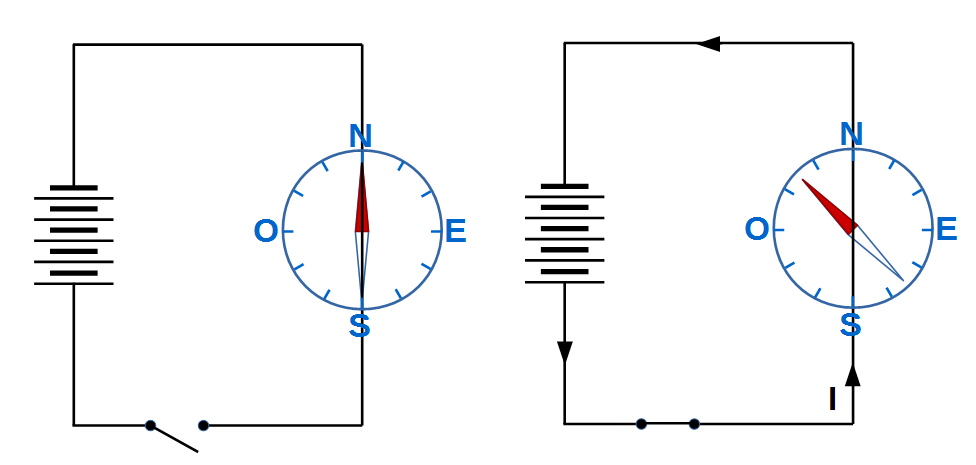
What did Oersted do in the experiment?
(A) Placed a compass near an electromagnet and observed its deflection
(B) Placed a compass near a magnet and observed the deflection of the compass
(C) Placed a compass near a current carrying wire and observed the deflection of the compass needle
(D) Placed a compass near an electrolyte and observed the deflection of the compass needle
Answer
452.4k+ views
Hint: To answer this question, we must know what Oersted experiment is, Oersted was a scientist who discovered electromagnetism. He discovered electromagnetism using this particular experiment mentioned in the given question.
Complete step by step answer:
Hans Christian Oersted was a Danish scientist who discovered electromagnetism.
Oersted did experiments on electric fields and magnetic fields. He found that the electric field creates a magnetic field around it through an experiment which is known as Oersted experiment. Now we will see about Oersted experiment

He took an insulated copper wire and connected it to a battery. When the battery is switched on the current passes through the wire. Oersted took a compass and placed it under the insulated wire. Whenever the current passes through the wire, the compass shows deflection. When the battery is switched off the compass does not show any deflections.
When the wire is placed in the north south direction the compass gets deflected towards the west direction. When the current is reversed the compass shows east direction.
The deflection in the compass whenever the current flows through the wire proves that the current carrying wire produces a magnetic field i.e. the electric field produces a magnetic field around it. The magnetic field produced from the electric field is known as an induced magnetic field.
Hence, the correct answer is option C) Placed a compass near a current carrying wire and observed the deflection of the compass needle
Note: In honour of Oersted's work on finding the relationship between magnetic and electric field, unit of magnetic field strength, Oersted is named after Hans Christian Oersted in Gaussian unit systems.
Complete step by step answer:
Hans Christian Oersted was a Danish scientist who discovered electromagnetism.
Oersted did experiments on electric fields and magnetic fields. He found that the electric field creates a magnetic field around it through an experiment which is known as Oersted experiment. Now we will see about Oersted experiment

He took an insulated copper wire and connected it to a battery. When the battery is switched on the current passes through the wire. Oersted took a compass and placed it under the insulated wire. Whenever the current passes through the wire, the compass shows deflection. When the battery is switched off the compass does not show any deflections.
When the wire is placed in the north south direction the compass gets deflected towards the west direction. When the current is reversed the compass shows east direction.
The deflection in the compass whenever the current flows through the wire proves that the current carrying wire produces a magnetic field i.e. the electric field produces a magnetic field around it. The magnetic field produced from the electric field is known as an induced magnetic field.
Hence, the correct answer is option C) Placed a compass near a current carrying wire and observed the deflection of the compass needle
Note: In honour of Oersted's work on finding the relationship between magnetic and electric field, unit of magnetic field strength, Oersted is named after Hans Christian Oersted in Gaussian unit systems.
Recently Updated Pages
Master Class 12 Social Science: Engaging Questions & Answers for Success

Class 12 Question and Answer - Your Ultimate Solutions Guide

Master Class 10 Computer Science: Engaging Questions & Answers for Success

Master Class 10 Maths: Engaging Questions & Answers for Success

Master Class 10 English: Engaging Questions & Answers for Success

Master Class 10 General Knowledge: Engaging Questions & Answers for Success

Trending doubts
The gas that burns in oxygen with a green flame is class 12 chemistry CBSE

Most of the Sinhalaspeaking people in Sri Lanka are class 12 social science CBSE

Draw a labelled sketch of the human eye class 12 physics CBSE

Differentiate between homogeneous and heterogeneous class 12 chemistry CBSE

Write a short note on Franklands reaction class 12 chemistry CBSE

Differentiate between insitu conservation and exsitu class 12 biology CBSE




